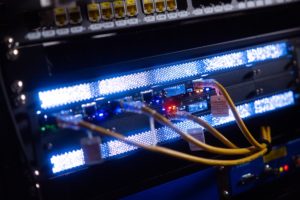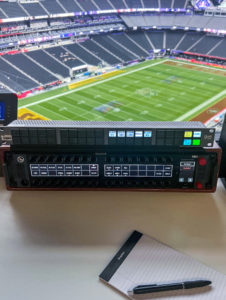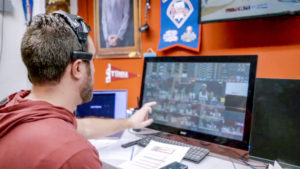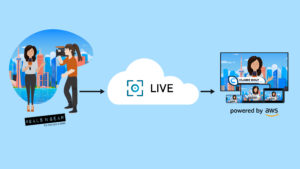
Fishing is believed to be the second most popular outdoor recreational activity in America second only to running, and the popularity of fishing-related TV shows worldwide, such as Extreme Fishing and Deadliest Catch, show that there is an equally large thirst for broadcast quality content for the armchair angler.
Fishing League Worldwide, better known as FLW, is the world’s largest tournament fishing organization, offering the largest and most prestigious fishing tournaments in the USA and around the globe, and the biggest awards in the sport. Based in Kentucky, FLW has been live streaming its national tournament weigh-ins since around 2007; in 2010 it began working with Digital P Media, a video production company based in North Carolina, to produce more content and extend its live coverage.
“We have partnered with FLW in producing TV shows for a long time, but over the last four years or so we have been trying to produce more high quality multi-platform content,” says Peyote Perryman, president of Digital P Media. “Digital video delivery has become something that a lot of people ask for now.”
The numbers speak for themselves; FLW’s main YouTube channel has over 93,000 subscribers, with 625,000 followers on Facebook, 272,000 followers on Instagram and 99,400 followers on Twitter.

However, live streaming the sport is something of a challenge when you’re in the middle of open water, often in countryside locations that are far from a metropolitan area or wifi network, and sometimes not even close to a cellular network.
“2013 was the first time we started live streaming from each boat,” says Doug Chessor, System Engineer, FLW. “It wasn’t ideal as we were working with a compressed signal from the cellular network, so it wasn’t robust enough to use a shoulder mounted camera. We knew we needed a camera and mic to be in the boat with each guy. We needed to be able to encode from the camera to a cloud server with bit correction, so when it came into the studio it would feel like a natural broadcast.”
The team tried mounting GoPro cameras fixed to a cellular modem in some of the leading boats to capture more action. “This was appealing to the audience, we had a good amount of fan reaction, but the screen was like an array of security cameras – there was too much to see, people didn’t know which feed to look at,” says Peyote. “We needed to be able to curate the feeds to focus the action, so we could follow a fisherman’s story as he solved problems on the way to landing a fish.”
In 2015 Digital P Media and FLW began researching options to find a sophisticated workflow that would be able to handle a three-pronged challenge: taking in multiple feeds, working with a weaker cell signal, and a camera that could maintain good picture quality.
“We looked at LiveU, Mushroom Networks and a few others,” says Peyote. “Then we tested JVC ProHD GY-HM890 cameras which had a built-in Zixi streaming engine – and it all fell into place. These two platforms worked together so seamlessly, with great pictures and a reliable signal, so it looked like the smart way to go.”
Doug agreed. “Maintaining signal from cameras out on the water was paramount – in the past it had been very patchy, but this partnership between Zixi and JVC gave us the reliability we needed,” he says. “Sometimes the cameras will move out of cellular service, but even when the signal goes down to one bar, Zixi can maintain that signal. This is where Zixi really shines – when we’re in trouble spots, it brings the most out of a low feed.”
Latency is also less of an issue than one might think. “Most people would assume we’d have 30-40 seconds of latency, but we’re actually closer to 7-10 seconds tops,” says Peyote. “It’s really nice that if something interesting happens on a boat, I can ask the camera operator to ask the angler a question and there isn’t a huge delay – that’s a pretty cool function. Zixi corrects the bit-packets and does it fast to keep the latency down.”
Out of FLW’s 200 US tournaments, Digital P Media covers 11 of the largest events, equating to 132 hours of live coverage – most of it on the water.
“The logistics of covering a bass fishing tournament are unlike any other sporting event,” says Peyote. “The competitors have this huge playing field – some of these lakes are 75 miles wide – and they can literally take their boats anywhere, so we have to try and cover every piece of action and build live stories across a six hour broadcast.”
Typically, Digital P Media’s work starts on day three of the tournament, once the field has been cut from 165 to 30 anglers. The cameras start recording from around 6am when the boats head out, with five JVC ProHD camera operators on the boats with the top five anglers and a live drone camera deployed to fly to any boat where a key piece of action is reported.
In addition, every boat has a marshal on board, equipped with a Zixi-enabled iPad to allow them to provide a real-time update of what’s happening on the boat, and to record video of catches. The GPS tracking of the iPad allows the production team back in the Kentucky studio to track each boat, so the main camera operators can be moved around to different boats as the leader board shifts. Each boat also has a GoPro mounted on the dashboard, recording throughout the day in case anything happens that the main cameras miss, and providing an additional layer of redundancy.
The six live HD feeds are sent back to the Zixi server in the studio in Kentucky, where the eight-strong production team puts together the first hour of action before the hosted live broadcast starts at 8am (local to the tournament).
“We pull the feeds from the Zixi server into a NewTek Connect Pro, which converts the Zixi signal to an NDI signal,” Peyote explains. “This then goes to a TriCaster TC1 live production system where we live-mix the show, and two NewTek 3Play systems where we can create instant replays.”
The whole crew – on site and in the studio – work hard throughout each day, constantly trying to stay ahead of the story and often dealing with unexpected twists.
“On a recent tournament we could see a really big thunderstorm coming in,” Peyote recalls. “We got the camera guys to shoot what they could before they had to take cover, while back in the studio we were suddenly preparing maps and rainfall statistics to put together a weather package. You just have to roll with what you get on a live shoot.”
Something that Digital P Media doesn’t worry too much about is the cost of data usage.
“At the start we were unsure what our data usage and therefore cost would be – streaming all day with five or six cameras could have been prohibitive, but we’ve been able to maintain a good quality signal without an exorbitant amount of data usage,” says Peyote. “With some pay-per-Gb systems you could pay a flat fee per day for a 12 hour window of data, and still end up using an extra Gb. Our usage hasn’t exceeded 500Gb over a weekend. It matters to us to do things efficiently – if it was too bandwidth heavy it would overwhelm any network.”
Now in the third year of using the Zixi Platform, FLW and Digital P Media are unanimous in their satisfaction with the system. “With multiple reliable, high quality feeds via Zixi, we have so much flexibility to tell these exciting stories in an engaging and professional way,” says Peyote.
Whether the anglers’ days end in triumph or disaster, FLW and Digital P Media can be sure that they will capture every moment.









